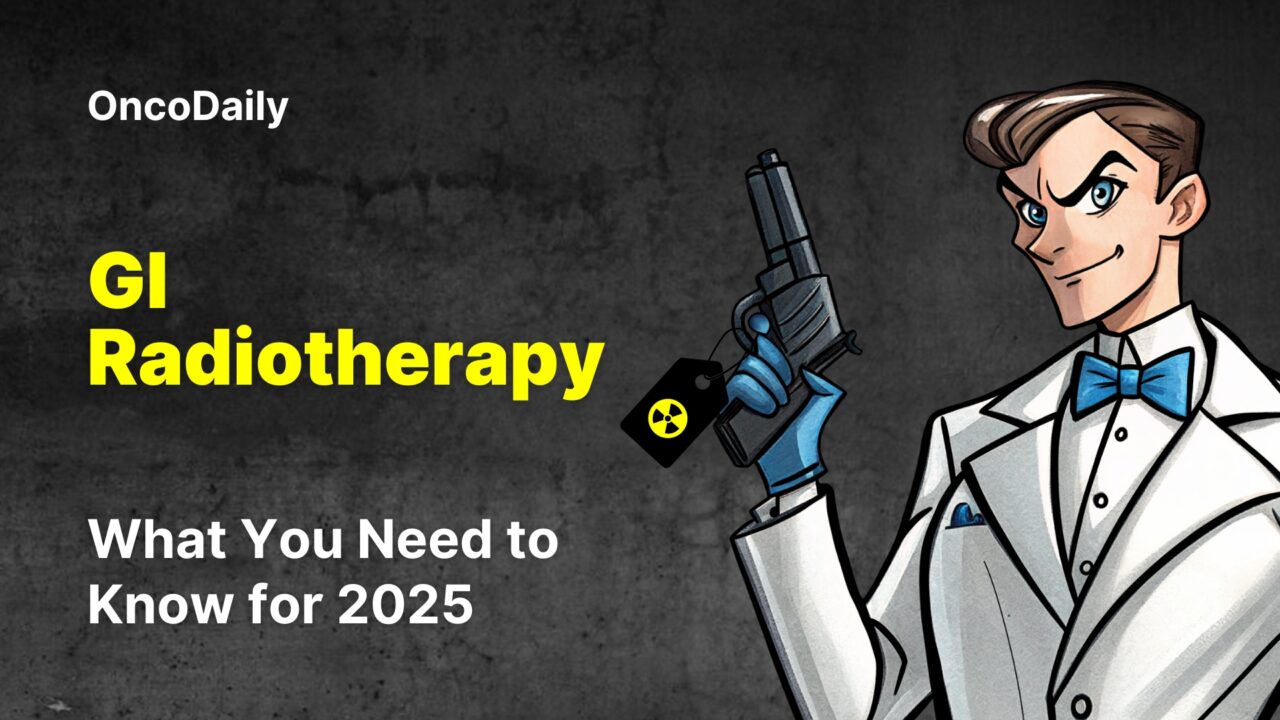
GI Radiotherapy: What You Need to Know for 2025
The landscape of gastrointestinal (GI) cancer treatment is continually advancing, and radiotherapy is no exception. As we look to 2025, significant innovations are emerging that promise to redefine how these challenging cancers are managed, offering new hope and improved outcomes for patients.
Stereotactic Body Radiation Therapy in GI Radiotherapy
A meta-analysis by Kamiyama et al., published in Radiotherapy and Oncology, compared SBRT and TACE for hepatocellular carcinoma (HCC) across various stages. The study found that SBRT offered comparable overall survival (HR: 0.83; 95% CI: 0.52–1.34; p = 0.44) to TACE, while demonstrating significantly improved local control (HR: 0.25; 95% CI: 0.09–0.67; p = 0.006). Both treatments showed liver toxicity as a common adverse event, but no significant difference in severe toxicities (grade 3 or higher) was observed. The authors suggest that SBRT, with careful peritreatment liver function assessment, should be considered an effective option for HCC patients at any stage.
This systematic review and meta-analysis by Sanuki et al., published in 2025 in the International Journal of Radiation Oncology, Biology, Physics, assessed outcomes and hepatic toxicity of stereotactic body radiation therapy (SBRT) for liver-confined hepatocellular carcinoma (HCC) and provided consensus guidelines for patient management. Seventeen observational studies (1889 patients, 2003-2019) were included in the aggregated data meta-analysis, showing 3- and 5-year overall survival (OS) rates of 57% (95% CI, 47%-66%) and 40% (95% CI, 29%-51%), respectively.
Local control (LC) rates at 3 and 5 years were 84% (95% CI, 77%-90%) and 82% (95% CI, 74%-88%), respectively. Tumor size was the sole prognostic factor for LC, while tumor size and region significantly influenced OS. Individual patient data analysis from 6 institutions (665 patients) showed 5-year LC and OS rates of 79% (95% CI, 0.74-0.84) and 25% (95% CI, 0.20-0.30), respectively.
Prognostic factors for improved OS included tumor size <3 cm, Eastern region, Child-Pugh score 5/6/7/8 and Barcelona Clinic Liver Cancer stage 0 and A. The incidence of severe hepatic toxicity varied by criteria. The study concluded that SBRT is an effective treatment for HCC with mature follow-up, leading to the development of clinical practice guidelines by the International Stereotactic Radiosurgery Society (ISRS).
Toxicity in GI Radiotherapy
The study, part of the OPRA trial, aimed to compare compliance and treatment-related toxicity in patients with locally advanced rectal cancer receiving total neoadjuvant therapy (TNT), specifically those randomized to induction chemotherapy followed by chemoradiation (INCT-CRT) versus chemoradiation followed by consolidation chemotherapy (CRT-CNCT). The broader purpose of the OPRA trial was to assess organ preservation rates and oncologic outcomes, as patients treated with TNT may achieve organ preservation without compromising these outcomes.
Of 324 patients, 93% of INCT-CRT vs 98% of CRT-CNCT started chemoradiation (P=0.03), and 99% of INCT-CRT vs 94% of CRT-CNCT started systemic chemotherapy (P=0.04). Completion rates for FOLFOX were 86% in INCT-CRT vs 83% in CRT-CNCT (P=0.60), and for CAPEOX were 74% in INCT-CRT vs 77% in CRT-CNCT (P=0.80). Radiation completion (>4500 cGy) was 97% for INCT and 98% for CRT-CNCT (P=0.93). Grade 3+ adverse events occurred in 41% (64 patients) of INCT-CRT and 34% (57 patients) of CRT-CNCT (P=0.30). Compliance and toxicity showed no association with organ preservation or DFS. This data was published in 2025 by Verheij et al. in the International Journal of Radiation Oncology, Biology, Physics.
A review by Lilleby et al. in the World Journal of Urology examined clinically relevant toxicity from major randomized controlled trials comparing conventional to hypofractionated radiotherapy (Hypo-RT) in the primary setting of external photon radiation for localized prostate cancer. While moderate Hypo-RT is established as iso-effective and safe, international guidelines vary on ultrahypofractionated radiotherapy (UHF-RT) for all risk groups. The review found that uncertain radiobiology of the urethra/bladder in extreme hypofractionation may contribute to worse acute urinary toxicity in Scandinavian UHF-RT and worse subacute toxicity in PACE-B.
Increased acute gastrointestinal toxicity in several moderate Hypo-RT trials and the Scandinavian Hypo-RT PC trial could be linked to different planning margins and dose schedules. Despite this, Hypo-RT is gaining acceptance for localized prostate cancer, with further improvements possible through genetic assessment of radiation sensitivity. The authors suggest future toxicity measurements should rely on patient-reported outcomes (PRO) using comparable questionnaires.

OncoDaily’s Special Article About Radiotherapy Toxicity!
Particle Therapy for GI Cancers
A study by Lee et al., published in 2025 in the International Journal of Radiation Oncology, Biology, Physics, assessed the long-term outcomes of definitive chemoradiation therapy (CRT) using proton radiation therapy (RT) with concurrent 5-fluorouracil (5-FU) and mitomycin-C (MMC) for localized anal cancer.
The prospective pilot studies involved 39 patients with stage I to III anal cancer, with a median follow-up of 63 months. The findings indicate a 5-year locoregional failure rate of 21%, distant metastases at 19%, colostomy-free survival of 72%, disease-free survival of 69%, and overall survival of 75%.
Regarding late toxicities, 38% experienced grade 1, 24% grade 2, 19% grade 3, and 3% grade 4, with no grade 5 toxicities reported. When compared to RTOG 0529, the study found significantly lower rates of overall grade 2+ late toxicities (46% vs 75%, P=.01), primarily attributed to reduced dermatologic toxicities (0% vs 25%, P<.01). However, there was no significant difference in overall grade 3+ toxicities (22% vs 20%, P=1.00). Patient-reported outcomes revealed persistent gastrointestinal symptoms in a significant proportion of patients over the long term.
The authors concluded that definitive CRT with proton RT offers comparable long-term disease control and grade 3+ late toxicities to conventional approaches, suggesting a potential benefit in reducing lower-grade toxicities. Further research is recommended to explore additional toxicity reduction strategies and identify patients who would most benefit from proton RT.
A 2025 study by Frederiks et al., published in the International Journal of Radiation Oncology, Biology, Physics, investigated the hypothesis that proton radiation therapy (PRT) could significantly reduce the incidence of pneumonia compared with photon radiation therapy (PhRT) in patients with esophageal cancer (EC). This study focused on patients undergoing neoadjuvant chemoradiation therapy (nCRT) followed by surgical resection, which is the current standard of care for EC but is often associated with complications like pneumonia.
The researchers conducted an analysis on a prospective cohort of 313 EC patients who completed nCRT with either PRT or PhRT and subsequently underwent esophagectomy between October 2014 and June 2022. Their findings revealed that 28% of the total patient cohort developed pneumonia. Crucially, the incidence of pneumonia was substantially lower after PRT (12%) compared with PhRT (32%), a statistically significant difference (P<.01). Through multivariable logistic regression, PRT was found to be associated with a significant reduction in the incidence of pneumonia (odds ratio [OR], 0.33; 95% CI, 0.14-0.72; P=.01), even after accounting for potential confounding factors such as the surgical approach and the size of the planning target volume.
To delve into the dose-effect relationships, the study utilized a principal component (PC) analysis of dose-volume histogram parameters for the lungs and heart. Three principal components were identified: PC1, associated with the mean dose in both the heart and lungs; PC2, related to the distribution of dose between the lungs and the heart; and PC3, linked to the volume receiving a low dose (≤20 Gy). When dose-related variables were replaced by these PCs, both PC1 (OR, 1.1; 95% CI, 1.02-1.22) and PC3 (OR, 1.27; 95% CI, 1.06-1.53) were significantly associated with the occurrence of pneumonia. Notably, PRT exhibited significantly lower values for both PC1 and PC3 when compared to PhRT.
The authors concluded that PRT significantly reduces the incidence of pneumonia in EC patients treated with nCRT followed by surgical resection. This beneficial reduction in pneumonia was directly correlated with the lower mean dose delivered and a decrease in the volume of the lungs and/or heart irradiated to low doses by PRT.
Written By Aren Karapetyan, MD
-
Challenging the Status Quo in Colorectal Cancer 2024
December 6-8, 2024
-
ESMO 2024 Congress
September 13-17, 2024
-
ASCO Annual Meeting
May 30 - June 4, 2024
-
Yvonne Award 2024
May 31, 2024
-
OncoThon 2024, Online
Feb. 15, 2024
-
Global Summit on War & Cancer 2023, Online
Dec. 14-16, 2023
